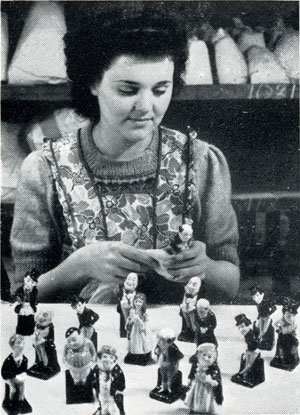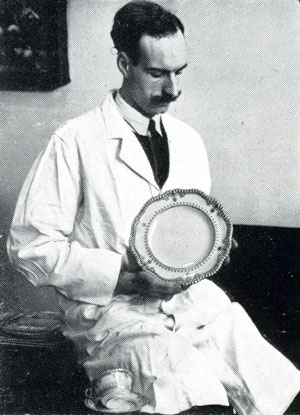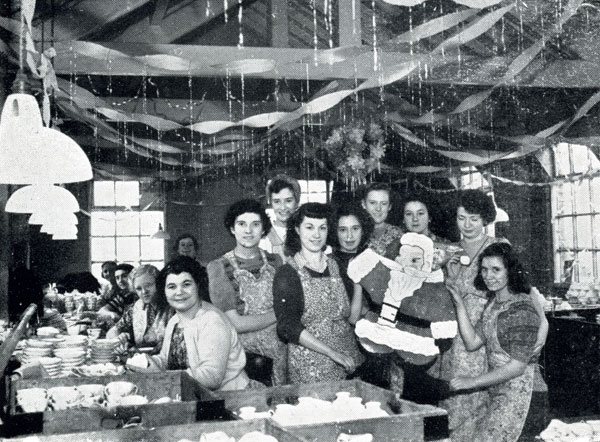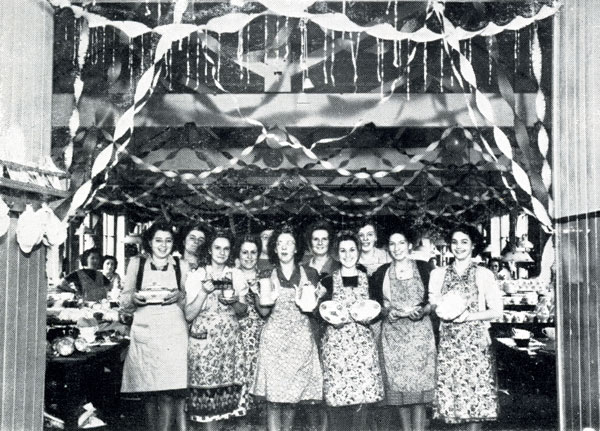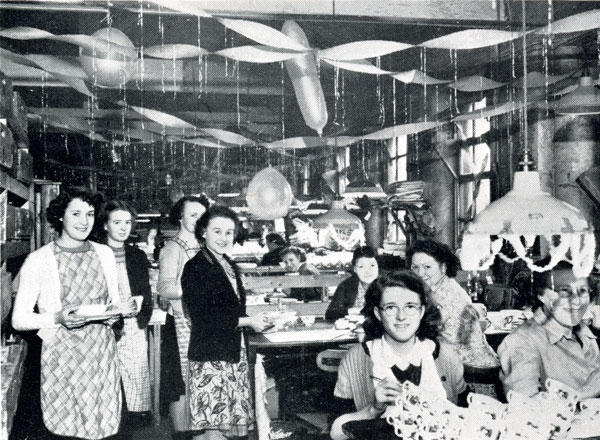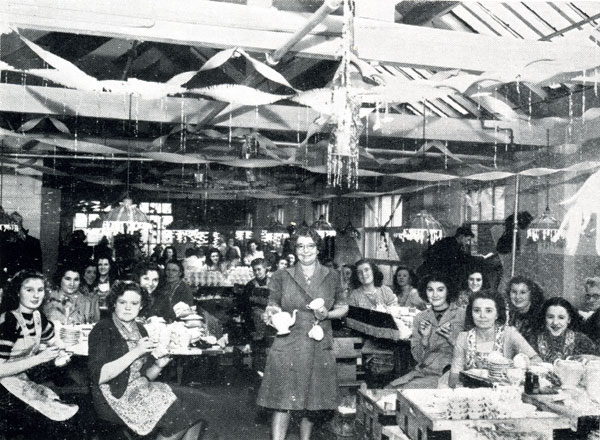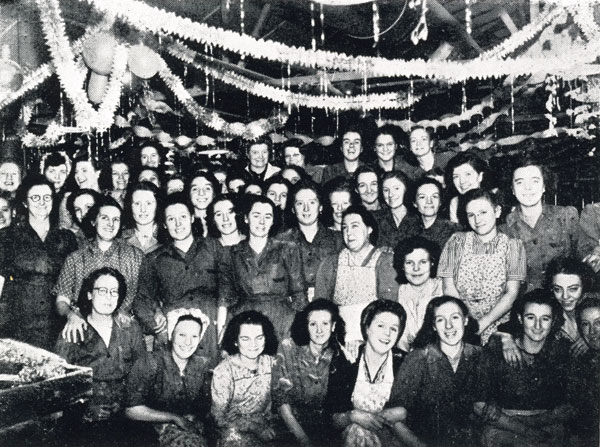Trade Journal UK
PGGTR 1950 January - Part 2 Editorial
- Details
- Category: Trade Journal UK
- Published on Monday, 05 March 2007 22:03
- Written by Administrator
- Hits: 16503
Pottery Gazette
and Glass Trade Review
January 1950
Continued
| Page 63 | ||
Pottery Gazette & Glass Trade ReviewEstablished 1875 Proprietors: Scott Greenwood & Son, Ltd.
Head Office:
Potteries Office: All communications to Head Office.
SUBSCRIPTION |
||
|
January 1950 Vol. LXXV. No. 871 CONTENTSPage Topics of the Moment … … … … … … 65 Chemical Control of Ceramic Production … … 67 New Hall Pottery … … … … … … 69 Old English Glassware … … … … … 70 Hints to Sales People … … … … … 76 Two China Shops … … … … … 80 Czech Glass Industry … … … … … 82 Pottery Export Prospects … … … … 84 Designed for Export … … … … … 85 Export News … … … … … … … 89 News … … … … … … … … 90 Christmas in the Potteries… … … … … 92 Glass Trade … … … … … … … 98 |
||
Page 63 Lower: Furnivals (1913) Ltd. China.
Page 64: Doulton & Co. Ltd.
| Page 65 |
Topics of the Moment....NEW YEAR GREETINGSTo all our friends in the pottery and glass trades, whether they be manufacturers, wholesalers, retailers, engineers, transfer or colour makers, we send best wishes for a successful and prosperous New Year. May 1950 be a year of continued full employment, though less harassed by the difficulties of 1949. It may be that many of the problems prevalent in 1949 will remain in 1950. It had been hoped (in some quarters it had even been prophesied) that before the old year was out some of the restrictions on the home market would have been relaxed. But it was not to be. Exhortations to export more and more came regularly from the Board of Trade and the Chancellor of the Exchequer. Devaluation brought renewed and intensified demands. Generally speaking, potters and glassmakers responded loyally to the call, while the great majority of retailers, with admirable and patient fortitude, sighed, shrugged their shoulders and prepared themselves for yet another period of trading with drab-looking shelves and showcases. They have had to put up with much. They sometimes grumble, but they undoubtedly understand. The prospects for 1950 are not easy to assess. Mr. Harold Wilson's report on his return from his American trip does not indicate any early relaxation of restrictions on the sale of decorated ware at home. “BEEFS” FOR LUNCHWe have seen a circular which has apparently been distributed in this country by a Canadian contemporary, The Gift Buyer. It bears the droll title: “We Get Canadian 'Beefs' for Lunch.” With customary North American vigour, it tells of a speech made at a luncheon table by an anonymous Canadian distributor of pottery and glass, In effect, the circular hits at British pottery manufacturers in general, and at an un-named one in particular. When one has sorted the wheat from the chaff, it is found that the un-named British manufacturer will be eight months behind with his delivery schedule this month. The Gift Buyer remarks that the Canadian organisation is “fed-to-the-teeth with having to put up with what they consider to be 'Business Nonsense'.” Adding fuel to the fire, the circular mentions a letter alleged to have been received from the British potter. We quote: “Yesterday (October 31) he (the Canadian speaker) got a letter from the same factory (believe it or not!) which now tells him that the wares won't be here for Christmas, but if all goes well ('and you must understand the terrific difficulties the potteries are working under at this time ') the distributor will probably get his shipments some time in January.” If the original intention was to circulate this story in Canada only, it seems a sure way of undermining confidence in British pottery there, particularly when it opens with a reference to “Alien pottery, back stamped 'U.S. Occupied Territory'.” Canadian readers of this Journal are kept well informed of the true situation here in the British potteries. We are producing to capacity, and as more and more mechanisation is introduced production will rise in proportion. Agitation in the form of literature which pours scorn and imprecations on the hard-working pottery manufacturer and his operatives in Britain is not helpful. The speaker at the luncheon quoted should come to Britain and see the situation for himself. Potters would welcome the opportunity to show him round and if he turns up on the right day he may get real beef for lunch. POETRY FROM THE POTTERIESInspired by the efforts of local Potteries artists to record for posterity “The Changing Face of the Potteries” (the title of an exhibition recently staged at Hanley Museum and Art Gallery), a contributor has sent us the following sonnet. The sentiments are worthy. It reads:
Amorphous seat of industry unplanned, A. E. D. BY AIRBy way of contrast to the comments under the heading of “Beefs for Lunch,” it is worthy of note that several potters are sending ware to America by air. Obviously all pottery could not be sent by that method, but this does show that the potters are “on their toes” to supply the North American market with all possible speed. The stories of delays can therefore be countered by other stories of speedy delivery, as will be seen by the notes on air delivery we publish in the News Section of this issue.
POTTERY GAZETTE AND GLASS TRADE REVIEW. JANUARY, 1950 |
Page 66 Mintons Ltd China.
Page 67 Article: Chemical Control of Ceramic Production - Possibilities of Spectroscopic Analysis.
Page 68 Josiah Wedgwood & Sons Ltd.
Page 69 Book Review: New Hall Pottery by George Eyre Stringer
| Page 70 {Glass Study - Pagination adjusted to keep paragraphd together} |
Old English GlasswareUnique and Priceless Collection at Brierley HillNo present-day designer of table glass for the world's markets can hope to achieve the best results unless he studies the very finest examples of the craftsmanship of his forebears. It is as well to remember that these 18th Century artists, who are today regarded as producers of the “near-perfect,” were in their own time beset, no doubt, by the pundits of such slogans as: “It won't suit our market”; or, “It lacks fitness for purpose.” Undeterred, they made what they knew would sell. How right they were! English glass has a high tradition of technique and perfection, which — to some extent both in Sweden and America — has received quick assimilation, and even quicker re-editing. 17th—18th Century CraftsmenContent though many of us are to allow these things to come to pass without audible objection, it is refreshing and encouraging to find that the crystal glassmakers of Stourbridge, taken as a whole, are keenly conscious of the artistic merits of the craftsmen of the 17th and 18th Centuries. A firm having a particular interest in the preservation of this type of work, is Stevens & Williams, Ltd., Brierley Hill, near Stourbridge. For many years the firm has had an extremely interesting museum collection consisting of rare and exquisite examples of the craftsman's skill in glass produced at the works over a period of several generations. So valuable is this collection, that in 1941 many of the specimens were despatched to Canada for safety. |
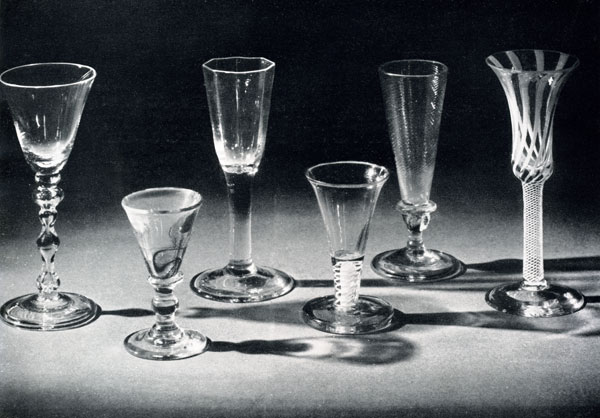 |
Plate 1.Styles of early drinking glasses, some of them very rare. From left to right:
(A) 7-inch trumpet-bowl, about 1760; |
| Page 71 |
Three-Generation CollectionMost of these pieces were proudly owned by the late Mr. Joseph Silvers Williams-Thomas. The present chairman of the firm, Mr. Hubert Silvers Williams-Thomas, who is a knowledgeable and enthusiastic collector, is responsible for the new Museum Room at the Moor Lane works, where there is now an extensive, fully catalogued display. To that display has been added his own private collection, as well as that of his son, Lt.-Col. Reginald Silvers Williams-Thomas, the present managing director. Forming part of the exhibits are old documents and record books of the company as well as of the local glass industry. Their purpose is three-fold: to interest buyers and foreign visitors in the tradition behind the craft of glass-making; to educate future generations of glass makers and decorators; and to show to the thousands of annual visitors how the treasures of the past compare with the products of to-day. |
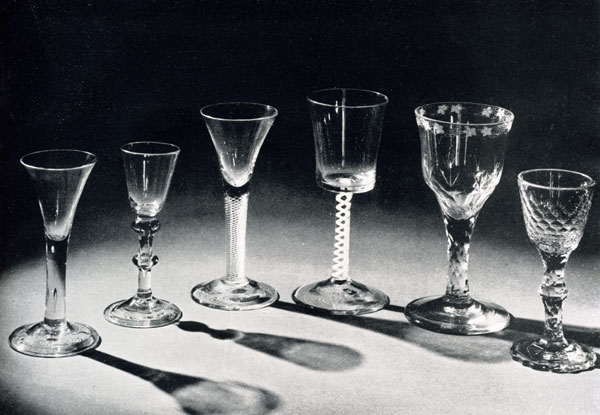 |
Plate 2.A group of six drinking glasses showing the development of decoration from the early plain glasses to the restrained, flat cuttings of about 1770. From left to right:
(A) 6-inch trumpet-howl wine glass, about 1700; |
| Page 72 |
Thirty Years’ SearchOf exceptional interest to the visitor is a complete collection (recently acquired by Mr. H. S. Williams-Thomas) of English and Irish glass of the 17th and 18th Century from a recognised authority and connoisseur. This rare and valuable addition to the Museum resulted from nearly 30 years of continuous search for genuine and perfect examples. Many of the pieces were found in the Midlands, though others have emanated from the West Country and from Scotland. By kind permission of the managing director of Stevens & Williams, Ltd., we are able to illustrate specimens from this most recent acquisition to the Museum. At some future date we shall hope to deal with the firm's original works pieces. The beautiful and interesting specimens of old English drinking glasses depicted in these pages are of unusual variety of form and finish. There are examples of heavy and light baluster stems; plain stems, with and without “tears”; some with exterior or incised twists; plain air spirals with drawn bowls; knopped air spirals with applied bowls; silver and mercury spirals; opaque white twists; single and compound opaque spirals mixed with mercury; faceted or cut stems; tazza-shaped and tall champagne glasses; ale glasses, goblets, and cordial glasses. |
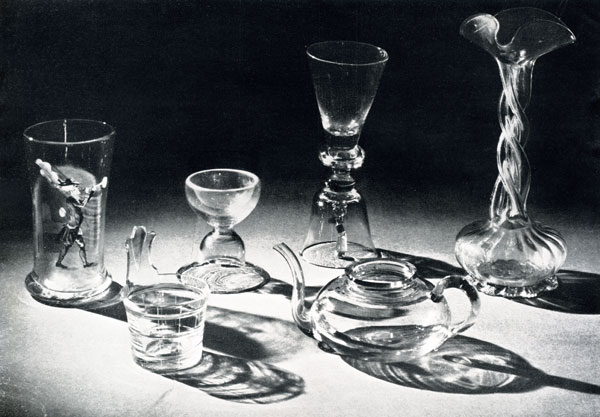 |
Plate 3.
|
| Page 73 |
Venetian Influence
|
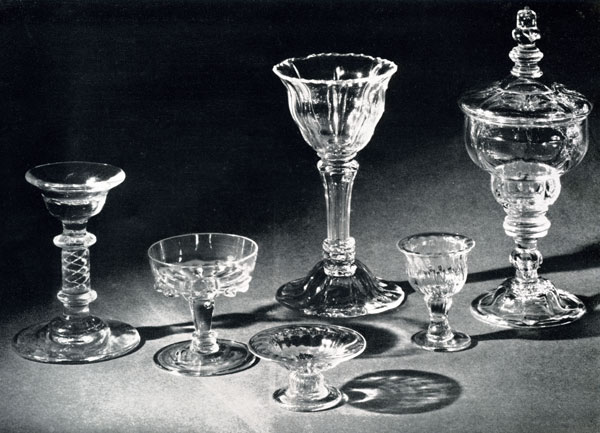 |
Plate 4.
|
| Page 74 | |
John GreenTestifying to this is a quaint old document written by John Greene to his Venetian agents on May 1st, 1671. It reads:— “Sir, I pray you once again to take such care that I may have good and be used very kindely in the prices, else it will not be miy interest to send to Venice for neither drinking glasses or looking glasses for we make now very good drinking glass in England.” The circumstances under which the Greene glass came into the collector’s possession amply illustrate the interesting adventures to be encountered in the pursuit of a hobby. The glass was bought with three others. Later the man from whom it had been purchased, learned to his surprise that he had parted with a Greene glass. He was so perturbed that he offered to repay the money he had received for the four glasses, though he was quite content to receive back only the Greene glass. Arms of BraganzaAn air of mystery attaches to one of the beautiful wine glasses (see Plate 6, Glass C). It has an engraved bowl. Beneath its base is a reflected “tear,” with a blob in the knopped stem; the foot is domed and folded. Although bought essentially as a fine specimen in perfect condition, it was the elaborate heraldic devices with which it was adorned that attracted the collector. A rubbing was taken and forwarded to the Royal College of Heralds for investigation. In due course it became known that this unique glass bore the arms of the Braganza family, the last reigning house of Portugal. |
|
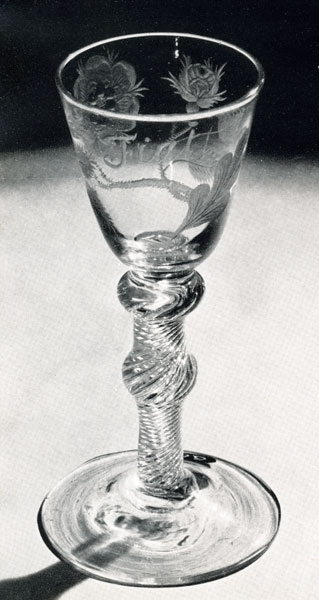
Plate 5.An historical glass of exceptional interest. It bears the While Rose of the Stuarts. {Circa 1730.) |
Jacobite GlassAnother item of great historical interest is a Jacobite glass made around 1730. It is double knopped with air twist stem, the bowl showing the White Rose of the Stuarts, the six-petalled quasi-heraldic rose, and the oak leaf. Engraved on the glass is the word “FIAT” (Let it be done). Such mementoes of Jacobite adherents were connected with the activities of an organisation known as the Cycle Club, which was first instituted on June 10, 1710, and took on a fresh lease of life in 1724. The slogan of the club was presumably the word “FIAT.” After the reconstruction of the club, it became customary for each member to possess one of these glasses. They were used for the purpose of drinking to “The King Over The Water,” the toast being drunk with members holding their glasses over the central bowl in pledging the King. They subsequently kissed the star engraved on the glass. Rush SprinklerAt least one other item is of special interest. It is a quaint piece of the late Tudor period—a rush sprinkler (see Plate 3) with a three-cornered “top hat.” This was used for scattering perfume on floors, the openings being placed so as to spray the perfume in three different directions when the sprinkler was in action. This valuable piece was sold many years ago to the late Dr. Hughes, of West Bromwich, by a Birmingham dealer as a flower vase! |
| Page 76 |
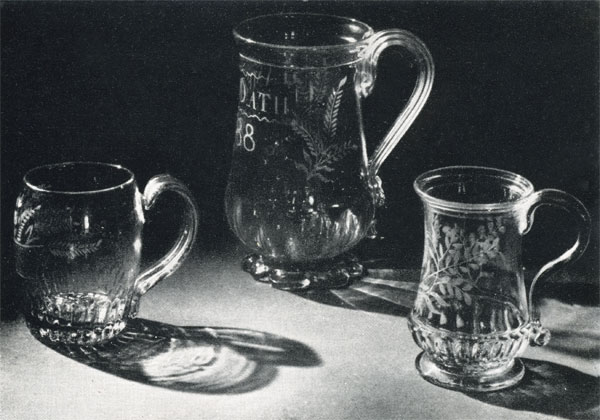 |
Plate 6.Three ale mugs from the Williams-Thomas private collection. From left to right:
(A) Small cupped in, ribbon handled, moulded base and star mug, about 1780;
(B) Large welted-edge mug with pillar moulded bowl, engraved sprays and “James Oath” about 1788;
(C) Small double-ring edge mug, engraved rose and sprays, about 1780. |
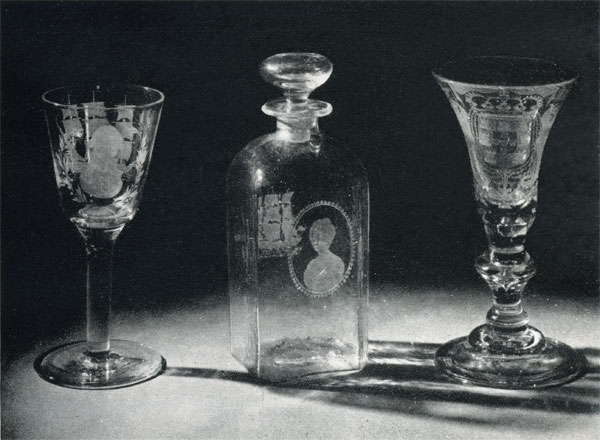 |
Plate 7.Early engravings by copper wheel and diamond point. From left to right:
(A) 8-inch conical bowl goblet with portrait of Admiral Spedway and his ship; |
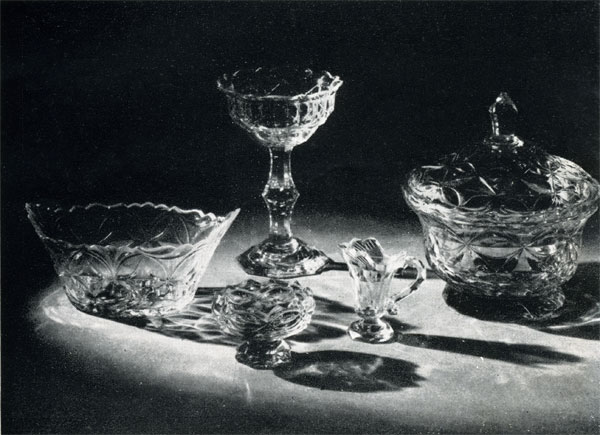 |
Plate 8.Fine early Irish glasses. From left to right:
(A) Oval fruit bowl, cut Waterford, about 1785; |
Page 76-79: Article: Hints to Salespeople 4. Appearnce and Identification of Products and Service Composition.
Page 80-81: Article: Two China Shops: W H Court, Canterbury. E C Haycock & Son, March.
| Page 82 |
Czech Glass IndustryIts Position Under Communism |
|
At a meeting of the Midlands Section of the Society of Glass Technology, Dr. F. Markovic, a refugee from the Communist Government in Czechoslovakia, gave a picture of the Czech glass industry under Communism. In the chair was Mr. Hubert Silvers Williams-Thomas, chairman of directors, Stevens & Williams, Ltd., Brierley Hill. Until the early part of 1948, Dr. Markovic was closely associated with the industry in Czechoslovakia, and was latterly an official of the Czech Ministry of Economics. For many years before the Communists came to power, the well-established factories were mostly in private ownership. By the time of the outbreak of war, some of them had become limited companies, many of them being owned by foreign capital, often German. Unemployment in 1930’sDuring the 1930’s, said Dr. Markovic, the economic crisis had caused widespread unemployment and many of the glass firms became bankrupt. As a result, a large number of skilled workers dispersed all over the world. Even before the war, therefore, there was feeling in some quarters that changes in the structure of the industry had become necessary if its future was to be ensured. There was even some talk of nationalisation, though not to the same extent as had taken place under Communism in the post-war years. Dealing with the events between the years 1945-48, Dr. Markovic said: “The foundation of democracy is legal security, and this is largely based on security of ownership. This was first breached during the German occupation when the share capital of all enterprises was reduced by as much as nine-tenths.” New shares, he said, were compulsorily issued up to the original amount and given gratis to German firms. National TrusteeshipThe final phases of the war had opened in an atmosphere of hostility, chaos, and disorganisation, thus providing an ideal breeding ground for Communism. During the latter months of 1945, said Dr. Markovic, the events that occurred would be difficult to understand by anyone not actually in Czechoslovakia at that time. When the Russians left, the Czech Government arbitrarily issued laws among which was one appointing a national trusteeship system for all the leading industries. In effect, this meant that legal and property rights were taken away from individuals and handed over to a State-nominated person, leaving the question of ownership in suspense. Since most of the glassworks had been owned by German capital, a large proportion of the industry automatically became State property. Responsible for the operation of the factories was the Ministry of Industry, who appointed trustees with managerial-ownership rights. This meant that the former owners and many directors (whether Czech nationals or not) had no access to their property. Complete Communist ControlNearly all trustees were Communists, and thus all industries were in their complete control. In the first instance, of course, there were but few qualified specialists in the Party, though it was not long before they were available in substantial numbers. A curious feature of events at this time was the removal of works’ owners and directors on the grounds that they were “anti-social.” Such a description was applied to any executive in the glass industry who at any time during the previous 20 years had had a dispute over wages or conditions, etc., with the workers, especially Communists. In the early stages, all glass works with melting-pot capacities of 220 gallons or over were nationalised. Although there was some talk about compensation for the former owners, nothing has so far been done in this respect, and Dr. Markovic said he was convinced no one would bother about it in the future. The next move was the grouping of all glassworks into 17 regional groups, some of which consisted of up to 14 factories. A central organisation was established in Prague with a consequent scramble and intrigue for the post of general managership. The main qualification, Dr. Markovic said, was political. Departments for Form FillingWhen the central organisation of Prague commenced to function, it did so with the aid of an avalanche of clerks, typists, etc. All factories had to employ special departments for form-filling, thus lowering their efficiency and seriously affecting their economy. Among the few favourable results from the new set-up was the bulk purchase of raw materials, and distribution of orders according to the size and technical ability and development of the works. Dr. Markovic said he had left Czechoslovakia in March, 1948, and could not say very much about events there since. He knew, however, that all non-Communist employees had been discharged. During the last twelve months, he had heard that sales departments had been divorced from the manufacturing side, the former now being divided into two separate departments, one (DUTA) being responsible for the home trade, and the other (VITREA) dealing with exports. The regional groupings were being abolished and individual works were now under direct control of the central organisation. One of the regional groups, Slovakian Glasswork National Corporation (no longer in existence) had consisted of five factories in Slovakia. The individual works were 100 to 200 miles from H.Q., and employees totalled about 2,500. Between 1946 and 1948 the regional groups had absolute managerial powers, although they were not allowed to make investments without consent of the central organisation and the Ministry of Industry. Soda-Potassium Table GlassThe production programme of Slovakian Glassworks consisted of soda-potassium table glass made by press moulding. Products were bottles and jars for all purposes, electric lamp bulbs, and Thermos flask linings. In 1947, lead crystal production was commenced. There was no lack of raw materials, though fuel was in short supply. Ovens were of an old type, being fitted with rotary coal generators or Siemens coal and wood generators. One works had a modern recuperative system and a number of small three-pot ovens. Three of the factories made their own melting pots from material largely available in Czechoslovakia but partly imported from Germany. The pots were of the open variety, being of 32 to 45 inches in diameter; they were dried from 8 to 12 months. Table glassworks used all the usual mechanical equipment, which was slightly less efficient than that used in this country. Wages and ConditionsWorking hours were 8 hours daily, 6 days a week. Wages were fixed by the Ministry of Labour, though its decrees in this respect constantly caused differences of opinion between management and workers. Wages consisted of cash, lodgings, light and fuel. Dr. Markovic gave the following cash wage scales at the pre-devaluation rate. Blower foremen earned from 2s. to 2s. 6d. per hour — their mates 10 to 40 per cent. less. Workers using semi-automatic machines earned is. 3d. to 1s. 6d. per hour, and unskilled labour about 1s. per hour. Female labour was paid according to skill, and varied from 10d. to 1s. 6d. per hour. Cutters constantly complained that the blowers were being paid better wages since the former averaged 1s. 9d. per hour, though they sometimes received as much as 2s. 3d. if they were top-grade workmen. Craftsmen's wages were fixed so that their earnings would amount to about £2 10s. per week, though this usually reached £3 to £4 per week after proficiency and other payments. Overtime was paid at time-and-a-half, while Sunday and night work was paid at double rate. Skilled workers were in short supply, and as a result, many were often lured from one factory to another. Production was maintained, however, mainly because the bulk of the workers were of German or Hungarian origin, and these were not allowed to change their jobs. Managerial SalariesSalaries of clerks were based on a very complicated order issued by the Ministry of Labour. Maximum salaries for non-managerial posts was £25 a month. A beginner typist received £8 to £9 a month. Experienced typists at H.Q. received £20 a month, while administrative clerks in Dr. Markovic's department received from £15 to £20 monthly. Extras were paid for overtime and efficiency. Works managers or heads of administrative departments received from £50 to £60 per month, while the managing director of Dr. Markovic's group earned £165 per month, all figures being gross and subject to income tax and social insurance deductions. The managing director's salary, for instance, was reduced to £85 per month by this means. Recruitment, Training, DesignRecruitment of young workers presented many serious problems. Even before the war, glass workers discouraged their children from entering the industry. At the present time, one glassworks is used as a training school to which youths and apprentices are sent for six-month courses. Despite intensive recruiting campaigns, the response was very poor indeed. The artistic side of production was adversely affected by too many shapes and patterns. In the case of Slovak Glassworks, there were so many designs in production or “on file” that there was little or no call for designers. New designs were primarily the responsibility of the Arts Department of the General Directorate in Prague. Moulds were generally made from hardwood, particularly oak, and were produced at the individual factory. Small quantities of steel moulds were also used, though in this case they were made by engineering contractors, who required about 6 months for delivery. Price FixingWorks costing and inland price fixing were haphazard and incomprehensible. Generally speaking, glass products for sale on the home market were fixed at about 83 per cent. above the pre-war level, as against a rise of about 400 to 500 per cent. in manufacturing costs. For example, soda-potassium plain sherries and ports were sold to the wholesaler at the equivalent of 4d. each. The latter was allowed to add 20 per cent. for sale to the retailer, while the retailer added another 33 per cent. for sale to his customers. There was no restriction on the sale of decorated glass to the home trade, and the method of price-fixing was related to the costs of decoration. Export PricesWith regard to the new export sales organisation established at the end of 1948, Dr. Markovic said that sales prices abroad were not based on calculation of first cost, but would be determined by the Communist Government’s need for the currency of the particular country concerned. In point of fact, said Dr. Markovic, the needs of the Government of the Soviet Union would be taken very seriously into account. An interesting example of the lengths to which prices of ware were reduced in order to obtain particular currencies was the pricing of hock glasses for sale to U.S. importers at 1s. 6d. each (f.o.b. Rotterdam) when the actual cost of production was 4s. 6d. each. Production FiguresDr. Markovic concluded by giving some production figures for a factory concerned with the manufacture of top-quality soda-potassium table glass. The factory in question had two furnaces which fed 19 chairs, each chair being manned by a foreman, two maids and one apprentice. This labour force produced 150,000 stem glasses per month, as well as 40,000 tumblers, and 8,oco larger pieces such as decanters, bowls, jars, etc. In 1947, this factory sold products of an average value per employee of £350. Wages for piece-work formed 46 per cent. of the total wages. The proportion of workmen to administrative and technical staff was 14:1. Average sales price of a metric ton of glass was £680, the weight of the finished articles being 52.5 per cent. of the weight of the original raw materials. |
| Page 84 | ||||||||||||||||||||||||||||||||||||||||||||||||||||||||||||||||||||||||||||||||||||||||||||||||||||||||||||||||||||||||||||||||||||||||||||||||||||||||||||||||||||||||||||||||||||||||||||||||||||||||||||||||||||||||||||||||||||||||||||||||||||||||||||||||||||||||||||||||||||||||||||||||||||||||||||||||||||||||||||||||||||||||||||||||||||||||||||||||||||||||||||
Pottery Export ProspectsNews from America and New ZealandUpon his return from America last month, Mr. Harold Wilson, President of the Board of Trade, in a statement to the Press, said that although he had been unable to visit the West Coast or the smaller inland towns, he was convinced there was a great potential demand for our exports in those areas. During his short tour he had been able to form certain general impressions partly as a result of the discussions he had had in Washington with British representatives and with American officials and business men. Among the items for which he gained the impression there was a big and unsatisfied demand was fine china. Whatever might be done to increase production and supplies, he said it was bound to be a long process. Another point, said Mr. Wilson, was that it had become clear to him that price was no longer the main problem. It was partly one of selling (including styling, packaging, etc.), but was mainly one of deliveries. Even where the price was favourable to the importer, he would not, in the speculative conditions of the American market, be prepared to enter into contracts for goods which took a long time to deliver, and, even worse, goods of which the delivery date was uncertain. Speed of delivery was of great importance, but it was just as important to stick to the date promised. With regard to fine china and earthenware, these were commodities of which we could sell perhaps four or five times as much if supplies were available. “As is well known,” said Mr. Wilson, “the sale of decorated and plain coloured pottery tableware to the home market (apart from export rejects) has been under a general ban for several years, and there is no question of rescinding this ban.” Exporters had been subject to strong pressure to increase their exports to the dollar areas, and he added significantly that “special favouritism” had been accorded to those exporters who had shown they could maintain a satisfactory dollar trade. Priority had been given to dollar exporters for facilities to increase their production, instances being the provision of building licences, new tunnel ovens, and the rationing of scarce industrial gas supplies. The supply of ceramic transfers had also given some difficulties, but action had been taken to secure improved supplies. Shortage of skilled decorating labour, however, remained difficult. In this respect, Mr. Wilson said that steps had and were being taken to make more of this type of manpower available — both trained and for training. “Every woman who enters this work,” he said, “can mean additional export earnings of about a thousand pounds a year.” U.S. DEPARTMENT STORES
Just before Mr. Wilson’s statement became available, there arrived from New York a list of British china and earthenware products likely to find a quick sale in U.S. department stores. The list was drawn up by the Committee Advisory to the Economic Co-operation Administration of the National Retail Dry Goods Association. Two conditions had to be met: (1) landed costs should permit profitable sale, (2) right delivery periods are required for their sale. The list is as follows: |
||||||||||||||||||||||||||||||||||||||||||||||||||||||||||||||||||||||||||||||||||||||||||||||||||||||||||||||||||||||||||||||||||||||||||||||||||||||||||||||||||||||||||||||||||||||||||||||||||||||||||||||||||||||||||||||||||||||||||||||||||||||||||||||||||||||||||||||||||||||||||||||||||||||||||||||||||||||||||||||||||||||||||||||||||||||||||||||||||||||||||||
|
||||||||||||||||||||||||||||||||||||||||||||||||||||||||||||||||||||||||||||||||||||||||||||||||||||||||||||||||||||||||||||||||||||||||||||||||||||||||||||||||||||||||||||||||||||||||||||||||||||||||||||||||||||||||||||||||||||||||||||||||||||||||||||||||||||||||||||||||||||||||||||||||||||||||||||||||||||||||||||||||||||||||||||||||||||||||||||||||||||||||||||
|
NEW ZEALAND MARKETThe New Zealand pottery industry, claiming to be suffering from the effects of the appreciation of the N.Z. pound and from prejudice against local goods, has placed before its Government detailed proposals aimed at safeguarding the home industry. The following table, which has been drawn up by the N.Z. Pottery and Ceramics Association, presents the estimated and potential capacity of N.Z. pottery manufacturers to supply the domestic market:
Footnote.Since these proposals were put to the N.Z. Government, the Customs Department has increased the pottery licence allocation for 1950 — and, of course, the Government has been changed. |
||||||||||||||||||||||||||||||||||||||||||||||||||||||||||||||||||||||||||||||||||||||||||||||||||||||||||||||||||||||||||||||||||||||||||||||||||||||||||||||||||||||||||||||||||||||||||||||||||||||||||||||||||||||||||||||||||||||||||||||||||||||||||||||||||||||||||||||||||||||||||||||||||||||||||||||||||||||||||||||||||||||||||||||||||||||||||||||||||||||||||||
Page 85-88: Article: Designed for Export (China)
| Page 89 |
EXPORT NEWSShippers MoveHenry Waugh and Co., Ltd., East India merchants, have removed to Palmerston House, 51, Bishopsgate, London, E.C.2 (London Wall 2027-29). The company have branches in Malaya, Singapore and Thailand. Exporters to Fiji, Tonga and Samoa, where they have their own organisation, Morris, Hedstrom, Ltd., have left Kingsway for 73, Cheapside, London, E.C.2 {City 2355). New offices at 178, Salisbury House, London Wall, London, E.C. (Monarch 1121) have been taken by Alex. L. Secretan and Co., Ltd., exporters to South America. J. March and Co., Ltd., who trade wholly with Spain, are now at 3-5, Rood Lane, London, E.C.3 (Mansion House 3676). Removal to Finsbury Court, Finsbury Pavement, London, E.C.2, is announced by the Commonwealth Trust, Ltd., and Landau and Coetsee, Ltd. The former, who ship general merchandise to West Africa and tile-making machinery to India, have the telephone number Monarch 5673. The two companies are unconnected. The Fitzgerald Trading Co., Ltd., are now at 18c, Cadogan Place, London, S.W.I (Sloane 7843). Mr. John S. Ray, who ships to Iran, Iraq, the Lebanon and Syria, has removed to 16, Sun Street, London, E.C.2 (Monarch 6387). Larger accommodation has been found at Eagle House, 90-96, Cannon Street, London, E.C.4 (Avenue 6655-58), by Khandelwals, Ltd., who export to all parts. New address of J. Grace, Ltd., London house of Grace Bros. (Pty.), Ltd., Broadway, Sydney, N.S.W., departmental store proprietors, is 10 13, Newgate Street, London, E.C.I (City 4961-63). Offices OpenedA. Nadir and Co., Ltd., 110, Fenchurch Street, London, E.C.3, export merchants, have reopened their office at Ferdinandstrasse 75, Hamburg, 1. A branch has been opened at 26, Pall Mall, Manchester, 2, by A. Murcott and Co., Ltd., East Anglia House, Helena Street, Parade, Birmingham, 1, exporters to India, Pakistan, Ceylon, Burma, Thailand, Malaya, Singapore, China and the Philippines. The managing director, Mr. P. Allen, is currently out East, and may be addressed c/o Raffles Hotel, Singapore. VisitorsMr. R. S. More, managing director, British Industrial Agencies, Ltd., Tangier, and Emporium, Ltd., Gibraltar, departmental store owners: c/o Fowlie, Reid and Willis, Ltd., 25, City Road, London, E.C.I. Mr. K. P. Mookherjee, managing director, East India Steel Works, Ltd., Calcutta: c/o 8, Brunswick Square, London, W.C.I. Buying glassware, domestic earthenware. Mr. Geoffrey Edward Davis, S. Hoffnung and Co., Ltd., Sydney, N.S.W., and Imperial House, Dominion Street, London, E.C.2, wholesale merchants. Mr. Stanley Prott, Pardale Trading Co. Propy., Ltd., Sydney, N.S.W., import and export merchants: c/o Commercial Banking Co. of Sydney, Ltd., 18, Birchin Lane, London, E.C.3. PersonaliaMr. L. K. Carter, managing director of Campbell Bros., Carter and Co., Ltd., 14-20, King William Street, London, E.C.4, is at present in Africa, where the company's subsidiaries include the London and Blantyre Supply Co., Ltd., of Blantyre, Lilongwe and elsewhere, and Campbell Bros., Carter and Co. (Central Africa), Ltd., of Kitwe, who control stores and retail shops throughout Northern Rhodesia. Mr. Carter sails for home from Cape Town on March 17. Mr. Robert F. Bradley, managing director of Carters (Merchants), Ltd., Winchester House, Old Broad Street, London, E.C.2, export and import merchants and buying agents, has been visiting the Sudan, where the company have developed important connections. The chairman, Colonel Wilfrid H. Ramsbotham, left in December to tour Australia, New Zealand and the Fiji Islands. He is due at Suva on April 1, and will return by way of Ceylon. Both hold several other directorships. Profits UpThe New Zealand Loan and Mercantile Agency Co.. Ltd., 197, Aldersgate Street, London, E C.1, increased net profits from £165,726 to £170,544 in 1948-49. Consolidated net profits of D. and W. Murray, Ltd., 197, Great Portland Street, London, W.1, Australia merchants, rose from £158,511 to £180,807. In ThailandThe Borneo Co., Ltd., 143, Fenchurch Street, London, E.C.3, have acquired the controlling interest in the S.A. Beige pour le Commerce et l’Industrie au Siam, of Bangkok, a retail business described as “a miniature Asprey’s.” Overseas InquiriesDominion Dairies, Ltd., 7460, Upper Lachine Road, Montreal, are anxious to obtain supplies of glass bottles and bottle caps from the United Kingdom. No indication is given of the exact requirements but it is understood that their annual purchases of glass bottle and bottle caps are extensive and if manufacturers are in a position to supply the firm’s requirements at competitive prices a large volume of business should result. The Dominion Dairies, Ltd., are said to operate four large plants situated at Ottawa, Winnipeg, Toronto and Montreal, and are engaged in supplying bottled milk to a large percentage of the population of those cities. Interested manufacturers should communicate with Dominion Dairies, Ltd., giving full details and quoting prices in Canadian dollars, f.o.b. and c.i.f., at the same time notifying the Board of Trade, Commercial Relations and Exports Department, Thames House North, Millbank, London, S.W.I, of any action taken, quoting reference CRE(IB)35O33/ 49. In the event of production difficulties hampering the fulfilment of this order firms should communicate with the Board of Trade (IM2B Division), Thames House North, Millbank, London, S.W.I. Telephone No. Victoria 9040, Extension 3220. The British Consul-General at San Francisco reports that the President of the American Fuchsia Society, some 1,500 to 1,700 members of which are reported to live in the Pacific Coast region, has approached him for information as to firms in the United Kingdom who are prepared to supply china or earthenware decorated with a fuchsia pattern. No precise information is given as to the volume of business to be expected, but we understand that all Pacific Coast members are anxious to obtain tableware of this pattern. Interested firms are requested to communicate with the Board of Trade, Commercial Relations and Exports Department, Thames House North, Millbank, London, S.W.I, quoting Reference No. CRE(IB) 33376/49, giving, if possible, details of existing or suggested patterns, together with c.i.f. and f.o.b. prices, delivery periods, etc. The Colonial Silver Co., 2223, N. Orange Avenue, Orlando, Florida, are anxious to establish contact with U.K. exporters of good-class dinner-ware and a less high-class type of dinnerware. The company want the dinnerware urgently and orders would probably amount to from $50,000 to $100,000. Firms interested in this inquiry should communicate direct with the Colonial Silver Co., sending full details and quoting prices in dollars c.i.f. Jacksonville, Savannah and Charlestown, together with illustrations and if possible samples, at the same time notifying the Board of Trade, Commercial Relations and Exports Department, quoting reference CRE(IB)35475/49. Haji Ali Al-Kahrabai, of Shourja, Khan Al-Dejaj, Baghdad, wish to get in touch with manufacturers and exporters of machinery and full equipment for manufacturing glass beads and bangles. POTTERY GAZETTE AND GLASS TRADE REVIEW, JANUARY, 1950 |
| Page 90 |
NEWSPottery Decorators from Italy?At a recent meeting of the Joint Industrial Council for the Pottery Industry, which was attended by Mr. Ness Edwards, Parliamentary Secretary to the Ministry of Labour and National Service, discussions took place with regard to obtaining skilled pottery decorators from Italy. It was decided that a party of four (two representatives each of the manufacturers and workers) should leave on Dec. 12 to interview suitable workers in Italy. These arrangements have had to be postponed, however, owing to the proximity of Christmas. As matters stand at present, the visit is likely to be made early in the New Year. The Pottery Gazette is informed that all expenses will be met by the British Pottery Manufacturers' Federation, whose representatives will be Mr. W. Anthony Adams, of William Adams and Sons (Potters), Ltd., Tunstall, and Mr. E. J. Johnson, Johnson Brothers (Hanley), Ltd., Hanley. Union officials will be Mr. Harold Hewitt, general secretary, and Mr. L. Jackson. Initial talks on the possibility of obtaining this much-needed labour took place last summer in Italy and London, and were made possible owing to the Italian Government decree which prevents Italian pottery manufacturers from dismissing their operatives without official consent. A number of Italian pottery workers, however, were redundant and many are being sent to various countries, including Sweden. The number of workers tentatively suggested as being ultimately available to come to Britain is put at approximately 2,000. In the first instance, an experimental number of about 50 may shortly come to this country. On arrival, they will be provided with hostel accommodation at Frobisher Hall, Swynnerton. No Decorated Ware “For a Long Time to Come”Replying to a question in the House of Commons, Mr. John Edwards, of the Board of Trade, said that in the prevailing circumstances it did not look as though it would be possible to relax the present restrictions on the sale of decorated ware in the shops at home for a long time to come. Overcharging for PotteryImposing fines totalling £2,700, with 150 guineas costs, in a Board of Trade prosecution under the Domestic Pottery (Maximum Prices) Order, 1947, Mr. Paul Bennett, V.C., the Marlborough magistrate, told two directors of Roedens, Ltd., pottery importers and exporters, of Noel Street, W.1:— “I am quite satisfied you did this with your tongue in your cheek. Everyone knows we can sell abroad far more pottery than we are producing. It comes back to the export for dollars question which is so very, very important today. You are intelligent business men and you knew very well that this pottery had no business on the English market.” On six summonses for selling as wholesalers tea and dinner sets at prices exceeding the maximum, the firm were fined a total of £900, with 50 guineas costs. The directors, Alfred Rose, of Clarendon Court, Sidmouth Road, Cricklewood, and Michael Emden, of Milverton Road, Kilburn, were each ordered to pay a similar penalty plus costs for aiding and abetting in the offences. 180 summonses were withdrawn. Mr. Bennett said that Mr. Chas. Lanson, counsel defending, had contended that the defendants had acted in the transactions as buying agents and that the extra charges made represented buying-commission. “I am satisfied,” he said, “that that was merely a cloak whereby increased charges could be received. . . . Unfortunately there are people who will buy commodities which are in short supply and ask very few questions either as to where they have come from or as to price. There is no question but that this company has been getting very considerable stocks of decorated pottery and it has been getting into shops where it has been sold at once.” Potteries J.P.'sAmong eleven appointments of new Justices of the Peace for the City of Stoke-on-Trent announced last month are Mr. Richard Howson Plant, director of R. H. and S. L. Plant, Ltd., Longton; Mr. Frederick Shepard Johnson, managing director, Johnson Bros. (Hanley), Ltd., Hanley; Mr. Harold Hewitt, general secretary, Pottery Workers' Society; and Mrs. Marian Hazel Moorcroft, the second wife of the late Mr. W. Moorcroft, of W. Moorcroft, Ltd., Burslem. Letter to the EditorU.S. MERCHANDISING NEEDSTo the Editor of the Pottery Gazette. Sir, You may recall I spent one week in Stoke. It was my initial visit, and therefore my experiences with its people made a profound impression — and I might add, a most pleasant one. Those whom I met were both helpful and delightfully hospitable. Early each morning, with fog and smoke overhanging the landscape, I would wonder how delicate ceramic work embellished with lovely designs could emerge from such an atmosphere. However, that is part of the genius of your pottery folk. It was my general impression in contacting your tea ware manufacturers of an unawareness of our merchandising needs and sales problems in the States. Our market requires certain shapes and types of pattern work, and in regard to these important points many manufacturers did not seem well informed. Sample displays were wanting in attractiveness and organisation, which made the process of selection difficult. The potteries have the demonstrated ability to manufacture what we need, but in the ever-increasing competition for the consumer dollar, it will require understanding and close co-operation between manufacturer and distributor to accomplish satisfactory ends. Herbert S. Marcus, 170, Fifth Avenue, New York 10, N.Y. Mr. C. Allen Joins Trilen Hardware Co.The Trilen Hardware Co., of Kingston-on-Thames, announce that Mr. C. Allen, a buyer and manager with 35 years' experience in import, export and home trade, has taken a half interest in the company. He has an expert knowledge of hardware, pottery, glass and all domestic consumer goods. Following 15 years with chain stores (6 years buying) he secured an appointment as hardware sales manager at Liverpool, with Lewis's, Ltd. After a period of seven years, he resigned in 1933 to take up an appointment as hardware buyer with Bentalls, Ltd., being promoted to merchandise manager in 1936. In 1944 he joined Gilbert J. McCaul & Co., Ltd., an old-established export house. |
| Page 91 | ||
Anglo-French Pottery BroadcastsVisiting Worcester Royal Porcelain Co., Ltd., Worcester, on December 5 and 6 were Mr. Robin Scutt (B.B.C. French Service Producer), M. Jean Bacon (B.B.C. French Service script writer and reporter), and M. Georges Clancier (Programme Director, Radio Limoges, French Broadcasting System). The purpose of the visit was to obtain information for programmes to be broadcast from London and from Radio Limoges. They will compare the work, social interests, and general background of workers in the British bone-china industry with the French fine hard-paste porcelain industry centred at Limoges. On December 7, Messrs. Scutt, Bacon, and Clancier spent some time at the works of Mintons, Ltd., Stoke, as well as visiting Mr. Harold Hewitt, General Secretary, National Society of Pottery Workers, at his Hanley office. On an earlier visit to Stoke-on-Trent, in connection with the same series of programmes, they held conversations with leading executives at Simpsons (Potters), Ltd., Cobridge; John Aynsley and Sons, Ltd., Longton; W. T. Copeland and Sons, Ltd., Stoke; and Josiah Wedgwood and Sons, Ltd., Barlaston. South African ImportsA Reuter message from Johannes burg last month said that it was hoped steps would be taken shortly to permit the entry into the Union of a limited quantity of hotel crockery and glassware. The Director of Imports, in response to approaches made by the Hotel Association of South Africa, the Hotel Ware Suppliers' Association and the Tourist Corporation, had arranged to investigate the position and had requested the Suppliers' Association to prepare a memorandum on the items in acute short supply. It is understood that some relaxation in import controls will take place in the first half of this year. Air-crash Escape of Mr. C. P. Slade
His colleagues and friends in the glass trade will be glad to hear of the escape of Mr. C. P. Slade, director of Joseph Lang & Co., Ltd., in the air disaster at Lyons, France, on Nov. 29, when several people were killed. Mr. Slade escaped with only slight injuries and is now back at work in Bath House, Holborn. |
||
SENT BY AIR |
||
|
A batch of Dickensian figures being packed at Doulton & Co., Ltd., just before Christmas for despatch to New York, where they were on sale a few days later. By special arrangement with British Railways and an American Air Line, the figures were hustled from the Potteries to London, and thence to Heath Row Airport, where they were loaded on to a trans-Atlantic plane. Doulton & Co., Ltd., say that the method of despatch is for the moment experimental. The relatively high air-freight charges will have to be carefully considered before deciding whether the method will be continued. |
|
Another famous firm of pottery manufacturers to send ware to America by air shortly before Christmas was W. T. Copeland & Sons, Ltd., Stoke-on-Trent. Our picture shows Mr. John R. Copeland, a director, posing with a plate from a richly gilt bone-china table-service, which was despatched by air to St. Louis via New York.In response to an urgent cable from a customer in Ceylon, Empire Porcelain Co. has sent a small consignment of dinner ware by air. It is understood that the pottery was destined for the Prime Minister of Ceylon. |
Pottery Talk to SoroptimistsMr. C. Clifford, joint managing director of Palissy Pottery, Ltd., Longton, last month addressed members of the North Staffordshire Soroptimists' Club. His subject was “The Manufacture of General Earthenware.” Lawleys Buy New FactoryThe Lawley Group of Potteries announced last month the purchase of a modern china factory in Stoke-on-Trent, specialising in the manufacture of floral china, figures and fancies. Mr. Edgar Lawley, Chairman of the Group, said the whole output of the factory would be “geared for sale in the United States and Canada.” It subsequently transpired that the factory was that of Floral China Co., Ltd., Longrton, which was sold by auction at Hanley on December 13 for £64,500. The purchaser identified himself as “Mr. Ferguson,” but declined to give further information. Bidding started at £40,000. In attendance were many local pottery manufacturers and executives. Co-operative Glass ProductionWith regard to the note which appeared in December, 1949, issue, the manager of the C.W.S. glass works at Worksop informs us that their production is keeping pace with steadily increasing sales and that their despatches made a 3 1/2 per cent, advance in the first 26 weeks of 1949—both in quantity and actual value. The supplies given in the December issue as £349,968 were for the two glass works. These “supplies” values vary considerably, due to the difference between package, credits and debits. This year there has been as much as £14.000 difference as compared with last year on this account. |
||
| Page 92 |
CHRISTMAS IN THE POTTERIES
At Thos. C. Wild and Sons, Ltd.
At Shelley Potteries, Ltd. |
Doulton Drama ClubOn Nov. 29 and 30, and December 1, members of the Doulton Drama Club gave performances of A. P. Dearsley's “Fly Away Peter” at the Bethel Church Schoolrooms, Burslem, Stoke-on-Trent. Large audiences of Doulton employees and their friends attended. The play (a comedy) featured the domestic entanglements of the Hapgood family. Members of the cast were: Austin Challinor (figure painter), Brenda Beckensall (Progress and Planning Dept ), Gladys Brassington (nurse), Eric Smith (Progress and Planning Dept.), Albert Crewe (head warehouseman) , Roy Mason (china figure caster), Phyllis Barnett (telephone receptionist), Douglas H. Challinor, the producer (production engineer), and Marie Smith (showroom). Pottery Managers’ Annual DinnerAt the George Hotel, Burslem, Stoke-on-Trent, on December 10, members (and their wives and friends) of the British Pottery Managers’ and Officials’ Association held their annual dinner. In a short address of welcome after the dinner, Mr. J.L.Williams, president, welcomed the members who had joined during the year, and said the Association was growing in strength. He hoped that during 1950, membership would increase still more. He paid tribute to the work of Mr. J. S. Adams, business manager, as well as to that of Mr. F. A. Timmins, the Association’s new General Secretary, who had just completed his first year in that responsible office. The president-elect, Mr. S. E. Glover, especially thanked the pottery managers’ wives who kindly allowed their husbands to attend the frequent branch meetings, as well as meetings at the North Staffs Technical College. Speaking of the lecturers, Mr. J. S. Adams said the Association deeply appreciated their services. They were all experienced and selfless men whose services were lent freely. He, too, wished to praise the work of Mr. Timmins, who had shown himself an astute and capable organiser. The organisation also acknowledged the cooperation and help received during the past year (as always) from The Pottery Gazette and “The Evening Sentinel.” Following the speeches, the gathering was entertained by a local concert party. Utilitarian Design“In recent years, we have heard too much of utilitarian design. Such a gospel is right and fitting in the sphere of simple objects — pots and pans — or more complicated things like ships and cars, but the fine arts are not pre-eminently concerned with use. Artists are not greatly concerned about the useful and the useless.” — Mr. G. J. V. Bemrose (Curator of the Hanley Museum and Art Gallery) speaking at the opening of the Stoke-on-Trent Arts Club Exhibition, held at The Brampton, Newcastle-under-Lyme, last month. M.A. for Mr. R. S. C. CopelandMr. Richard Spencer Charles Copeland, member of the well-known firm of W. T. Copeland and Sons, Ltd., Stoke-on-Trent, has received the degree of Master of Arts at Cambridge University. |
| Page 93 |
 |
Crystal by Webb CorbettThos. Webb & Corbett Ltd.Stourbridge, England. And at Tutbury. |
| Page 94 |
CHRISTMAS IN THE POTTERIES
At Hammersley and Co. (Longton), Ltd.
At E. Brain and Co., Ltd. Mrs. Dawson (centre), an overlooker, has been with the firm for forty years. |
Germans Visit the PotteriesA party of Germans were entertained to dinner at the King's Hall, Stoke, last month, by the Lord Mayor of Stoke-on-Trent, Dr. A. P. Spark. They were visiting the city as part of a course organised by the Foreign Office, and designed to educate suitable Germans for the responsibilities of positions of public importance. Following the dinner, Mr. John Wedgwood (Josiah Wedgwood and Sons, Ltd., Barlaston) gave a talk, speaking in German, on the history and importance of the pottery industry. Footballers Visit PotteriesMembers of the Wealdstone F.C., who played their F.A. Cup-tie match against Port Vale F.C. at Hanley last month, paid visits to Paragon China, Ltd., Longton, and John Aynsley and Sons, Ltd., Longton, before the game. F.B.I. Criticism of Development CouncilSpeaking at a luncheon in London, last month, Sir Robert Sinclair (President of the Federation of British Industries) questioned the wisdom of the Government's intention to set up Development Councils in industries where employers were averse to them. The activities of such Councils mainly affected management, Sir Robert said, and to try to impose them in the face of managerial opposition was surely the height of unwisdom. It would be nothing but a waste of time, money, and effort, and would distract from far more important matters, the minds of those without whose co-operation the Councils' functions could not produce any useful results. He could not understand the Board of Trade's determination to proceed with their plans, when the employers were quite prepared to participate in the voluntary alternative of the statutory body. The employers were prepared to support it practically and financially, and were willing to have an independent chairman. A body set up and constituted on those lines, Sir Robert declared, would have far greater potentialities for achievement. Studying U.S. Packaging MethodsThe Anglo-American Council on Productivity has sent a specialist team to the U.S.A. to examine the ways in which American goods are made up for retail sale and display. The team sailed on December 2, and will be in America until January 28. Representing the Glass Manufacturers' Federation is Mr. Francis George West-Oram, glass technologist, Wood Bros. Glass Co., Ltd., Barnsley. Minton's New China WorksIt may be remembered that about two years ago plans were drawn up for extensions to the china works of Mintons, Ltd., Stoke-on-Trent. Official approval has now been given to an extension which is to house an electrically-fired glost tunnel oven. The next stage will be the erection of a new suite of administrative offices and showrooms. Commemoration Pottery for U.S. UniversityA large order (reported to be worth $85,000) has been placed with Josiah Wedgwood and Sons, Ltd., Barlaston, for the manufacture of commemorative pottery for a leading U.S. educational institution. |
Page 95 Advert - Paragon china
| Page 96 |
CHRISTMAS IN THE POTTERIES
At George Wade and Son, Ltd. |
Houses for Wedgwood EmployeesOn December 2, six newly-built houses on the Barlaston Park Estate became the homes of employees of Josiah Wedgwood and Sons, Ltd., Barlaston. The houses were the first of fifty being erected by the Stone Rural District Council. Forty of them will be allocated to key workers at the factory. The twenty houses already in occupation on the estate were erected by the Wedgwood company just before the war. Building restrictions caused the original plans to be postponed early in the war. At a special ceremony in honour of the occasion, speeches were made by Mr. F. R. Hill (chairman of Stone R.D.C.), Mr. W. B. Oldacre (the Council’s architect) and the Rev. C. W. Salt (chairman of the Housing Committee). Later, following tea at the factory canteen, the Hon. Josiah Wedgwood said that the firm had a pre-war contract for the building of 156 houses. By next spring, he said, there would be about 70 occupied houses on the estate. Also in attendance at the ceremony were Mr. John Wedgwood, Mr. Tom Wedgwood and Mr. Maitland Wright, directors. Donald Mills Pottery ExhibitionAn exhibition of Donald Mills pottery is being held this month at Barrow's Stores, Corporation Street and Bull Street, Birmingham, 2. German Pottery ExportsBavarian pottery producers expect to increase their exports considerably as a result of the O.E.E.C. plan for the liberalisation of intra-European trade exchanges, says Reuter. They hope to be able to sell 20 million dollars’ worth of technical and household pottery annually to E.R.P. countries compared with shipments to all destinations of 8-9 million dollars a year at the present time. Royal Visit FilmThe city of Stoke-on-Trent is to receive from the J. Arthur Rank Organisation and British Movietone News films of Princess Elizabeth's recent visit to the Potteries. They were shown to the public during the week commencing December 5, and have now been handed to the civic authorities for permanent retention. ExhibitionsRowland Carvendale, Ltd., will be exhibiting their new season’s range of table lamps and lamp shades at the Prospect Hotel, Harrogate, from Jan. 9-13. An exhibition of pottery was held at the Paul Alexander Gallery, Kensington Church St., London, W.8, from Dec. 1-31, when "Pottery for the Home" was shown by John Bew, Marianne de Trey, Peter Holdsworth, Donald Mills and Margaret Rey. Pottery and Glass Wholesalers’ AssociationAt the annual general meeting of the Pottery and Glass Wholesalers' Association the following officers and executive committee were elected: — Chairman: Mr. R. J. I. Silberrad (Shorter Bros.). Vice-Chairmen: Mr. C. N. Brad-nock (Osier and Faraday, Ltd.), and Mr. J. H. Bridgett (E. A. Bridgett, Ltd.). Hon. Treasurer: Mr. J. W. Taylor (James Taylor). Executive Committee: Mr. P. S. Bailey (Hardware (Bristol), Ltd.), Mr. A. H. Bullock (Chas. Bullock (Blackburn), Ltd.), Mr. J. Ewart (A. Sheddon and Sons, Ltd., Glasgow), Mr. C. H. Frost (C. H. Frost and Co.), Mr. A. T. Godwin (Hales, Hancock and Godwin, Ltd.), Mr. T. P. Hayward (T. Hayward and Co.), Mr. H. M. Housden (C. Mc.D. Mann and Co., Ltd.), Mr. C. Preston (J. Preston and Sons (Earthenware), Ltd.), Mr. R. C. Taylor (Taylor Bros., Ltd., Leeds), Mr. G. B. Yeates (A. Yeates and Sons, Ltd.). At the meeting there was a discussion on the black market in decorated pottery and suggestions were made regarding the steps likely to remedy it. Value of the WholesalerSpeaker at the November dinner/meeting of the Stoke-on-Trent branch of the Incorporated Sales Managers’ Association, held at the Grand Hotel, Hanley, was Mr. A. S. Renwick, of Brown Brothers, Ltd. Mr. Renwick spoke at some length on the value to the manufacturer of the reputable wholesaler, emphasising his ready-made sales staff, and his intimate knowledge of the retailers' difficulties and requirements. Booths and Colcloughs’ Annual DanceThe Longton factory of Booths and Colcloughs, Ltd., held its second Annual Dance at Trentham Gardens, Stoke-on-Trent, on December 16. Music was provided by Norman Jones and the Trentham Ballroom Orchestra. A Pottery Opens in Puerto RicoA new factory for the production of restaurant and institutional pottery has been opened in Vega Bajo, Puerto Rico, says Reuter. The plant, which, opened by the Crane China Corporation, is the first to be established commercially on the island and has an ultimate capacity of 25,000 pieces weekly. |
| Page 97 |
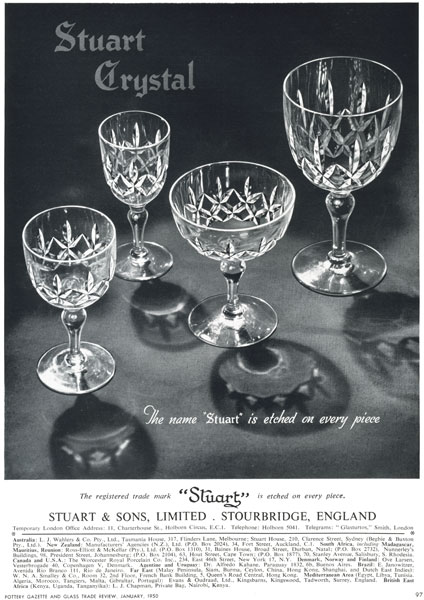 |
Stuart CrystalThe name “Stuart” is etched on every piece.The registered trade mark “Stuart” is etched on every piece.STUART & SONS, LIMITED . STOURBRIDGE, ENGLANDTemporary London Office Address: 11, Charterhouse St., Holborn Circus, E.C.1. Telephone: Holborn 5041. Telegrams: “Glasturtos,” Smith, London Australia: L. J. Wahlers & Co. Pty., Ltd., Tasmania House, 317, Flinders Lane, Melbourne; Stuart House, 210, Clarence Street, Sydney (Begbie & Buxton Pty., Ltd.). New Zealand: Manufacturers' Agencies (N.Z.), Ltd. (P.O. Box 2024), 34, Fort Street, Auckland, C.1. South Africa, including Madagascar, Mauritius, Reunion: Ross-Elliott & McKellar (Pty.), Ltd. (P.O. Box 1310), 31, Baines House, Broad Street, Durban, Natal; (P.O. Box 2732), Nunnerley's Buildings, 98, President Street, Johannesburg; (P.O. Box 2104), 63, Hout Street, Cape Town; (P.O. Box 1877), 70, Stanley Avenue, Salisbury, S. Rhodesia. Canada and U.S.A.: The Worcester Royal Porcelain Co. Inc., 234, East 46th Street, New York 17, N.Y. Denmark, Norway and Finland: Ove Larsen, Vesterbrogade 40, Copenhagen V, Denmark. Argentine and Uruguay: Dr. Alfredo Kahane, Paraguay 1832, 6b, Buenos Aires. Brazil: E. Janowitzer, Avenida Rio Branco 111, Rio de Janeiro. Far East (Malay Peninsula, Siam, Burma, Ceylon, China, Hong Kong, Shanghai, and Dutch East Indies): W. N. A. Smalley & Co., Room 32, 2nd Floor, French Bank Building, 5, Queen's Road Central, Hong Kong. Mediterranean Area (Egypt, Libya, Tunisia. Algeria, Morocco, Tangiers, Malta, Gibraltar, Portugal): Evans & Oudraad, Ltd., Kingsbarns, Kingswood, Tadworth, Surrey, England. British East Africa (Kenya, Uganda, Tanganyika): L. J. Chapman, Private Bag, Nairobi, Kenya. |
| Page 98 |
GLASS TRADEINQUIRIES in the Birmingham and Stourbridge flint glass trade made on the eve of the Christmas holidays indicated that the leading firms would start the New Year with fairly good commitments on overseas account. The position may not be as favourable as it was twelve months ago, but in the domestic and fancy ware section there is every indication that capacity production will be required during the opening months of 1950 in order to keep pace with the volume of export orders on hand. The past year has been a more difficult one from the point of view of securing new business because of the extensions of import restrictions, but a perusal of the Board of Trade returns for the first nine months of the year suggests that the total output for 1949 will at least equal that of the previous twelve months. The indications are that the improvement in the demand by South Africa and “other British countries” will counterbalance the falling off in trade with Australia, British East Africa, and foreign countries. So far as Australia and New Zealand are concerned, an improvement was noticeable during the quarter ended Sept. 30, and if that continued during the final quarter, 1949 may show better results than those indicated by the Board of Trade returns for the first nine months. Although devaluation of the £ has not brought a rush of orders from the U.S.A., it is generally admitted that the position has slightly improved. December brought many useful additions to the order books from countries still open to purchase domestic and fancy ware, the month comparing favourably with November. It is generally estimated that the business on hand when the glass houses closed down for the Christmas break was somewhat less than it was a year ago. Overseas commitments, however, are regarded as sufficient to provide full employment during the first two months of the New Year. Commenting on the export position, at the annual dinner of the Birmingham and District Branch of the Institute of Export, Sir Graham Cunningham, Chairman of the Triplex Safety Glass Co., Ltd., declared it was idle to talk about British exports to the dollar markets till every branch of industry, politics, and the Civil Service were thinking along lines free from prejudice of every sort. Our exports were more than sufficient to cover imports, and but for the currency difficulty Britain would not be in her present economic position. Many of the fruits of our productivity were being swallowed up in expenditure which did not contribute to our productive effort. The plain truth was we could not afford luxuries. Four Dudley girls have joined the boy apprentices now taking part in the special training scheme initiated by S. & W. (Lighting), Ltd., makers of illuminating glassware, Dudley Port, Tipton, to overcome the shortage of glass blowers. They are amongst the first girls in the Midlands to become apprenticed to this section of the industry. Dr. R. Halle, General Manager, states that during 1949 the firm established a new record output on overseas account. North-Eastern DistrictThe end of the old year found the glass manufacturing industry in this area as busy as ever. There continues to be a steady flow of orders to the various branches of the trade and this is likely to continue as long as the present demand for export is maintained. Since the devaluation of the pound there has been a bigger demand for glassware from overseas, and factories are working full time to cope with the orders from abroad as well as for the home market. In the bulb and tube section of the industry there continues to be a big demand for the output of the works, and, of course, as much as possible is being despatched overseas. Newburn Urban District Council has been approached by the Minister of Town and Country Planning regarding buildings of special architectural or historic interest in the area covered by the Council. Several buildings in the district are regarded as being worthy of preservation, one of these being the old disused glass kiln at Lemington and Sugley. A familiar figure in the glass manufacturing industry in this district has been removed by the death of Mr. Nicholson Barrass, of Douglas Gardens, Dunston. Mr. Barrass, who was 65 years of age, had spent a lifetime at Lemington Glass Works, where he began work as a glass blower 46 years ago. He gradually advanced from stage to stage until he reached the position of supervisor at the works. His funeral at Dunston was attended by many of his former colleagues. |
Sand for Crystal GlassAt a meeting of the Midands Section of the Society of Glass Technology held at the Talbot Hotel, Stourbridge, on December 5, Mr. R. E. Threlfall presiding, Mr. W. E. Cook, a director of Stuart and Sons, Ltd., Stourbridge, spoke on “The Purification and Handling of Sand for Use in Crystal Glass.” Mr. Cook illustrated a method of washing, drying, and sieving sand, and of a method of conveying it by pneumatic means. By this method it was possible to remove impurities to such an extent as to bring the sands well within the standards laid down by the Society. Figures were produced to show that it was possible to so purify Loch Aline sand that it became equal to the best of the imported sands. Mr. Cook emphasised that washing was the important part of the process, and that sieving was the least satisfactory by virtue of the difficulties of ensuring complete extraction over a very fine screen. During the discussion which followed, a number of members described their own methods of handling sands, and Mr. Astles passed round some interesting pictures of the mining operations at Loch Aline. English Glassware for Egyptian Royal YachtsStevens & Williams, Ltd., Brierley Hill, near Stourbridge, have received an order for cut crystal glassware to re-equip the three yachts of the Egyptian Royal Family, viz: H.M.Y. Mahroussa, H.M.Y. Kassea Keir, and H.M.Y. Fakhr el Bihar. Pottery CostingMr. E. H. A. Wheen, Accountant to the Worcester Royal Porcelain Co., Ltd., addressed a meeting of the Stoke-on-Trent branch of the Institute of Cost and Works Accountants on December 2. His paper was entitled “Some Aspects of Standard Costing as applied to a Pottery Factory” Adderleys’ Christmas PartyEmployees (and their friends) of Adderleys (Longton), Ltd., attended a party given at the Dun-robin Hotel, Longton, last month, A concert party later provided entertainment. |



